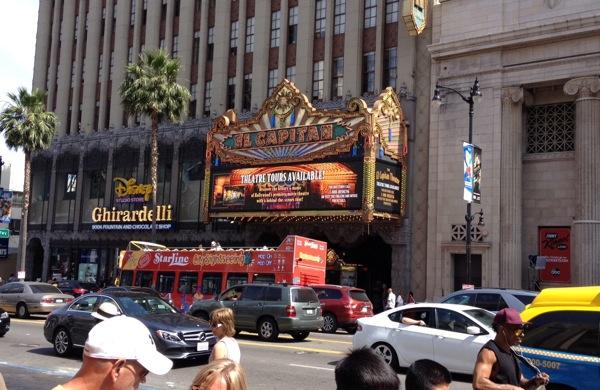Dolby Cinema Part Deux

But first a little background. I stated in that other blog that Dolby Vision (which promotes a wider color gamut and high dynamic range, or HDR) was primarily developed for flat screen sets, which can produce greater brightness (practically speaking, up to around 300 foot-lamberts in an affordable consumer displaythough Dolby’s pro display can do much better at considerable cost). For commercial film presentations, Christie Digital has developed, in cooperation with Dolby, a new, laser-lit projector capable of 30 ft-L (in 2D and, of course, depending on screen size and gain).
If that doesn’t sound like a patch on 300 ft-L, keep in mind that most theatrical projectors are lucky to hit 15-16 ft-L (again in 2D, and far lower in 3D). While the Dolby Vision projectors can’t equal the top end brightness of an HDR flat screen set, they can produce deeper blacks than those in most theatrical digital presentations. (The latter’s black levels are, in general, mediocre at best, and easily exceeded by the best home theater projectors.) Theatrical Dolby Vision can therefore produce a sensation of high dynamic range even while they can’t match what a properly designed flat screen HDR set can do.
I also speculated in that prior blog as to how a laser projector can produce deeper blacks, though my theory (the lasers scanning the DLP chips) was wrong. I haven’t seen any confirmation as to exactly how they do it, but it appears to be that two layers of DLP chips are used for each color. More on this when we can confirm it. What we do know, however, is that the lasers do not illuminate the screen directly (which could be hazardous to the vision of any member of the audience who looked back at the projector!) but rather are used as an illumination source for DLP.
The movie was beautiful to look at...perhaps, technically, the best theatrical feature film presentation I’ve ever seen.
In any event, Dolby also refers to its theatrical video as Dolby Vision, just as they do their flat panel HDR format. The full assortment of video and audio theater enhancements is known as Dolby Cinema. Dolby Vision at present is available in only four theaters in the U.S., though several more are expected by late July. One of the theaters currently equipped with Dolby Vision is the El Capitan in Hollywood. Since I was heading back to LA for the recent Orange County Hi-Fi show, I couldn’t resist extending my stay long enough to visit the El Capitan to see Dolby Vision in its first theatrical release: Tomorrowland. (The OC Hi-Fi show is officially known as T.H.E. Show, for The Home Entertainment Showyou can read my blogs on it as part of our sister publication Stereophile’s show report.)The movie was beautiful to look at, with excellent effects, though it was more than a little incoherent with a heavy dose of preaching (on climate change, human folly, money and power grubbing will bring on the apocalypse, and how the smart and enlightened can save us all). But that was all beside the point. It was perhaps, technically, the best theatrical feature film presentation I’ve ever seen, challenged for that honor only by the memory of a 70mm film restoration of Ryan’s Daughter I saw at the Samuel Goldwyn theater in Hollywood some years ago).
I estimate that the El Capitan’s screen is roughly 40-50 feet wide not the biggest screen in LA but typical of many of the best theaters nationally. The image couldn’t have been more naturally sharp. The projected Dolby Vision images popped spectacularly, but were never uncomfortably bright (something I fear may happen with HDR on flat panels with their 10x greater peak levels, given the tendency of marketers to amp everything up). It was also nearly 3D, though this was a 2D presentation.
And at their best, the blacks were deep and inky. I say “at their best” because they clearly varied throughout the film. They were never poor, but rarely were quite as good during the film as they were in the opening Dolby credits (where they were amazing) or in parts of the closing credits. Some star fields, for example, definitely had grayish blacks. They didn’t equal, overall, the blacks I see on the best flat screen plasmas, OLEDs, and well-designed, full-array local dimming LCD sets. But nevertheless they were a dramatic step up from the blacks achievable in most theatrical digital presentations.
The only downer was knowing that I won’t likely be able to experience Dolby Cinema in my area of northwest Florida until, oh, perhaps 2025!
























































